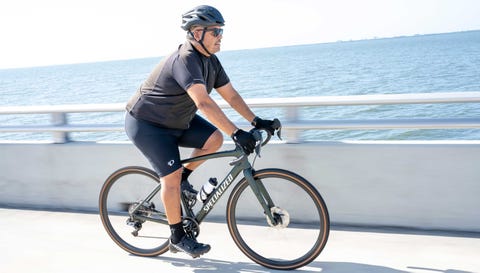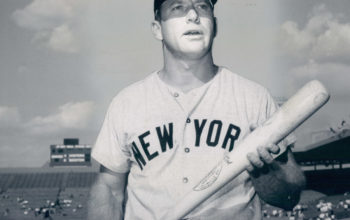When Bruce McCarthy was diagnosed with brain cancer, cycling kept him balanced.
BEING ON TWO WHEELS DEFINES BRUCE MCCARTHY’S LIFE, AND HE DIDN’T LET CANCER KNOCK HIM OFF.
The following written content by Alex Crevar
Bruce McCarthy can best be described as a classic grease-under-the-fingernails bike shop guy. As the store manager at Outspokin Bicycles in Clearwater, Florida, he can, at once, order next season’s fleet of bicycles from manufacturers, ring up an in-store sale, encourage an aspiring cyclist, and change the bottom bracket on a rig in the repair stand. Being on two wheels, and making it easy for others to do the same, defines his life.

The 51-year-old husband and father of two rides for fitness and competes in triathlons. He pedals to run errands and to join friends on weekend outings. For four decades, Bruce has been climbing on the saddle for entertainment, transportation, and refuge; riding helps him find balance.
In January of 2020, that balance began to list. Without warning, Bruce suffered a grand mal seizure. He was headed to the shop when he suddenly became confused and felt, as he describes, “swimmy.” He returned home, where his wife noticed his increasingly clammy skin before the convulsions began. Then everything went black for the next 24 hours.

When he woke again in the hospital, a team was searching for reasons why such a catastrophic event would befall someone so active with no history of illness and no alcohol or drug addictions. The determination was that a past concussion, which Bruce believes could have come from a number of tumbles while playing sports over the years, had left scarring on his brain. Per post-seizure protocol, he was not allowed to drive for six months and told not to cycle alone.
“I have no recollection of the seizure,” Bruce told Bicycling over the phone. “But I was scared in the hospital when they started labeling me as an epileptic. I saw my freedom and independence rapidly flying away.”
When he eventually started riding again, Bruce either rode with friends, especially if he was in a remote area, or his wife tracked him via Wahoo. But then in October 2020, while at home, he started to have that swimmy feeling again. He texted his wife to come home; when she arrived, he was already unconscious. This time, after he awakened from another day of seizure-induced darkness, advanced neurological tests had been ordered. The next two months were a swirl of MRIs, CT scans, and EEGs. Read more from Bicycling.






